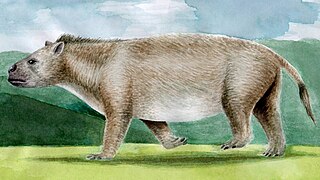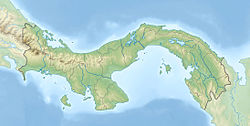
Pseudhipparion is an extinct genus of three-toed horse endemic to North America during the Miocene. They were herding animals whose diet consisted of C3 plants. Fossils found in Georgia and Florida indicate that it was a lightweight horse, weighing up to 90 pounds. In 2005, fossils were unearthed in Oklahoma. Seven species of Pseudhipparion are known from the fossil record which were very small, following the trend of Bergmann's rule.

Nannippus is an extinct genus of three-toed horse endemic to North America during the Miocene through Pleistocene, about 13.3—1.8 million years ago (Mya), living around 11.5 million years. This ancient species of three-toed horse grew up to 3.5 feet and weighed between 165 pounds to 199 pounds, which was around the same size as a domestic sheep.

Cormohipparion is an extinct genus of horse belonging to the tribe Hipparionini that lived in North America during the late Miocene to Pliocene. They grew up to 3 feet long.

Tsoabichi is an extinct genus of caimanine crocodylian. Fossils are known from the Green River Formation in Wyoming, and date back to the Ypresian stage of the Eocene. The genus was named and described in 2010 by paleontologist Christopher A. Brochu, with the type species being Tsoabichi greenriverensis. According to the current understanding of caiman evolutionary relationships, Tsoabichi is a basal member of Caimaninae and may have evolved after caimans dispersed into North America from northern and central South America, their main center of diversity in the Cenozoic.

Alligator prenasalis is an extinct species of alligator from the Late Eocene period. It is well known, with many fossils having been collected from the Chadron and Brule Formations in South Dakota. The species was first named in 1904, but was originally classified as a crocodile in the genus Crocodilus. It was reassigned to the genus Alligator in 1918 on the basis of more complete material. It is the earliest known member of the genus Alligator.
Aguascalientia panamaensis is an extinct species of miniature camels found in Panama first described by Aldo F. Rincon et al. in 2012.
Culebrasuchus is an extinct, monotypic genus of caiman alligatorid known from the Early to Middle Miocene (Hemingfordian) of the Panama Canal Zone of Panama. It contains a single species, Culebrasuchus mesoamericanus.
Centenariosuchus is an extinct genus of caimanine crocodylian known from the Miocene of the Panama Canal Zone of Panama. It contains a single species, Centenariosuchus gilmorei, that was named in 2013 in honor of the upcoming centennial anniversary of the digging of the Panama Canal. Two fossil specimens consisting of skull fragments were found in the Early to Middle Miocene Cucaracha Formation in 2009 and 2011, and may belong to a single individual. The species is diagnosed by a combination of skull features that it shares with basal caimans like Tsoabichi, Eocaiman, Culebrasuchus, and the living genus Paleosuchus, as well as more derived caimans such as those in the genus Caiman. One feature that distinguishes Centenariosuchus from all other caimans is the straight outer margin of a hole on the underside of the skull called the suborbital fenestra. According to one phylogenetic analysis of caimanine relationships, Centenariosuchus falls within a clade or evolutionary grouping of caimans that includes the very large and highly specialized forms Purussaurus and Mourasuchus, known from the Miocene of South America.
Globidentosuchus is an extinct genus of basal caimanine crocodylian known from the late Middle to Late Miocene of the Middle and the Upper Members of the Urumaco Formation at Urumaco, Venezuela. Its skull was very short and robust, with large units of spherical teeth used to break the shells of molluscs as part of its durophagus diet. It is thought to be one of the most basal Caimanines, even sharing some traits with alligatorids.
The Astoria Formation is a geologic formation in Washington state & Oregon. It preserves fossils dating back to the early to middle Miocene.
The Culebra Formation (Tcb) is a geologic formation in Panama. It preserves fossils dating back to the Miocene period; Early Miocene epoch, Aquitanian to Burdigalian stages. Fossils of Culebrasuchus have been found in and named after the formation. The thickness of the formation is at least 250 metres (820 ft) thick, and the age has been estimated as from 23 to 19 Ma.

Etayoa is an ungulate of the family Carodniidae in the order Xenungulata that lived during the Early Eocene in northern South America.
Panamacebus is an extinct genus of monkey known from the Early Miocene of central Panama. Panamacebus transitus is the only and type species of this genus.
Scaphokogia is an extinct genus of pygmy sperm whales that lived off the coasts of Mexico and Peru, South America during the Late Miocene to Late Pliocene. Two species have currently been described: the type species S. cochlearis and S. totajpe. Fossils of Scaphokogia have been found in the Tirabuzon Formation of Baja California and the Pisco Formation of Peru. Scaphokogia existed about 5 million years ago, and were relatively rare animals.

Alligator olseni is an extinct species of alligator. They lived in the Early Miocene period, around 20.4–15.97 million years ago and possibly earlier. Their range was principally in what is now known as Florida, United States, and possibly extending into southeastern Texas.
Rhinoclemmys panamaensis is an extinct species of turtle belonging to the genus Rhinoclemmys of the family Geoemydidae known from the early to middle Miocene (Hemingfordian) Cucaracha Formation of the Panama Basin of central Panama.
Alligator mcgrewi is an extinct species of alligator described by K.P. Schmidt in 1941. They lived in the Early Miocene period, and their range was principally in what is now Nebraska, United States.
Alligator thomsoni is an extinct species of alligator that existed during the Early Miocene period. Their range was principally in what is now known as Nebraska, United States.
Alligator mefferdi is an extinct species of alligator described by Charles Craig Mook. They lived in the Miocene period, and their range was principally in what is now Nebraska, United States. The type specimen was discovered in the Ash Hollow Formation at Ash Hollow State Historical Park.












